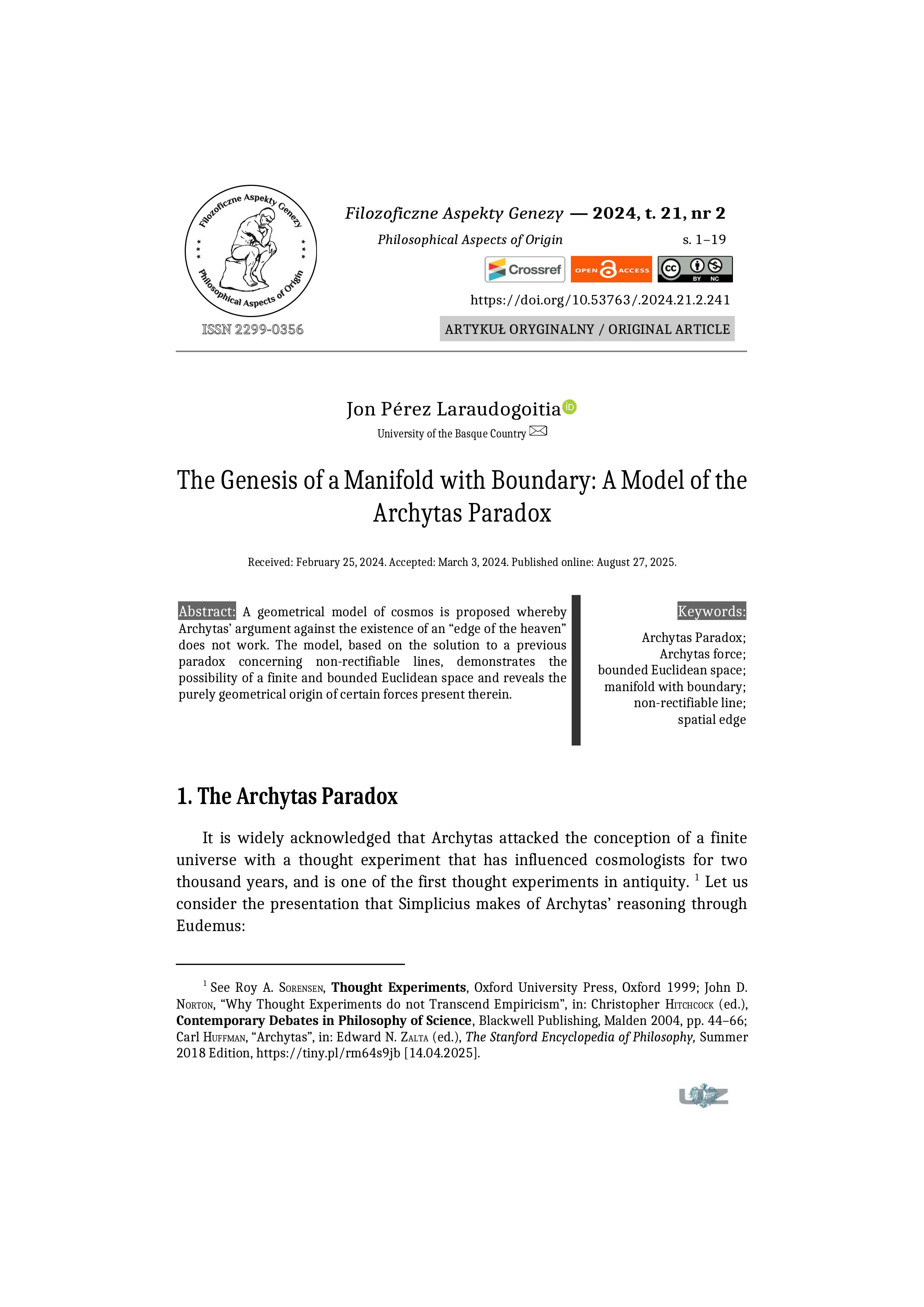Artykuły

Opublikowane 30.11.2024
Słowa kluczowe
- Archytas Paradox,
- Archytas force,
- bounded Euclidean space,
- manifold with boundary,
- non-rectifiable line
- spatial edge ...More
Prawa autorskie (c) 2025 Filozoficzne Aspekty Genezy

Utwór dostępny jest na licencji Creative Commons Uznanie autorstwa – Użycie niekomercyjne 4.0 Międzynarodowe.
Jak cytować
Jon Pérez Laraudogoitia, The Genesis of a Manifold with Boundary: A Model of the Archytas Paradox, Filozoficzne Aspekty Genezy 2024, vol. 21, no. 2 https://doi.org/10.53763/fag.2024.21.2.241
Abstrakt
A geometrical model of cosmos is proposed whereby Archytas’ argument against the existence of an “edge of the heaven” does not work. The model, based on the solution to a previous paradox concerning non-rectifiable lines, demonstrates the possibility of a finite and bounded Euclidean space and reveals the purely geometrical origin of certain forces present therein.
Downloads
Download data is not yet available.
Bibliografia
- Aristotle, Physics, Book IV, 212b5–10, in: Richard McKeon (ed.), The Basic Works of Aristotle, Random House, New York 1941, pp. 269–302.
- Belot Gordon, Geometric Possibility, Oxford University Press, Oxford 2011. DOI: https://doi.org/10.1093/acprof:oso/9780199595327.001.0001
- Cao Tian Yu, Conceptual Developments of 20th Century Field Theories, Cambridge University Press, Cambridge 1997. DOI: https://doi.org/10.1017/CBO9780511563997
- Cini Enrico and Fano Vicenzo, Careful With Those Scissors, Eugene! Against the Observational Indistinguishability of Spacetimes, Studies in History and Philosophy of Science Part A 2021, Vol. 89, pp. 103–113, https://doi.org/10.1016/j.shpsa.2021.07.007. DOI: https://doi.org/10.1016/j.shpsa.2021.07.007
- Curiel Erik, Singularities and Black Holes, in: Edward N. Zalta and Uri Nodelman (eds.), The Stanford Encyclopedia of Philosophy, Summer 2023 Edition, https://tiny.pl/yxr9rnfv [14.04.2025].
- Esposito Giampiero, Kamenshchik Alexander Yu., and Pollifrone Giuseppe, Euclidean Quantum Gravity on Manifolds with Boundary, Springer, Dordrecht 1997, https://doi.org/10.1007/978-94-011-5806-0. DOI: https://doi.org/10.1007/978-94-011-5806-0
- Frankel Theodore, The Geometry of Physics: An Introduction, Cambridge University Press, Cambridge 2004.
- Gilmore Cody, Calosi Claudio, and Costa Damiano, Location and Mereology, in: Edward N. Zalta and Uri Nodelman (eds.), The Stanford Encyclopedia of Philosophy, Spring 2024 Edition, https://tiny.pl/q2h0mb_4 [14.04.2025].
- Huffman Carl, Archytas, in: Edward N. Zalta (ed.), The Stanford Encyclopedia of Philosophy, Summer 2018 Edition, https://tiny.pl/rm64s9jb [14.04.2025].
- Huggett Nick, Everywhere and Everywhen: Adventures in Physics and Philosophy, Oxford University Press, Oxford 2010. DOI: https://doi.org/10.1093/acprof:oso/9780195379518.001.0001
- Johnson Monte Ransome, Sources for the Philosophy of Archytas, Ancient Philosophy 2008, Vol. 28, No. 1, pp. 173–199, https://doi.org/10.5840/ancientphil20082819. DOI: https://doi.org/10.5840/ancientphil20082819
- Le Poidevin Robin, Travels in Four Dimensions: The Enigmas of Space and Time, Oxford University Press, Oxford 2003. DOI: https://doi.org/10.1093/oso/9780198752547.001.0001
- Martin Gottfried, Kant’s Metaphysics and Theory of Science, Manchester University Press, Manchester 1955.
- Nerlich Graham, The Shape of Space, Cambridge University Press, Cambridge 2009.
- Norton John D., Why Thought Experiments do not Transcend Empiricism, in: Christopher Hitchcock (ed.), Contemporary Debates in Philosophy of Science, Blackwell Publishing, Malden 2004, pp. 44–66.
- Petersen Mark A., Dante and the 3-sphere, American Journal of Physics 1979, Vol. 47, No. 12, pp. 1031–1035, https://doi.org/10.1119/1.11968. DOI: https://doi.org/10.1119/1.11968
- Priest Graham, Beyond the Limits of Thought, Cambridge University Press, Cambridge 1995.
- Rovelli Carlo, Some Considerations on Infinity in Physics, in: Michael Heller and Hugh W. Woodin, Infinity: New Research Frontiers, Cambridge University Press, Cambridge 2011, pp. 167–175. DOI: https://doi.org/10.1017/CBO9780511976889.009
- Rucker Rudy, Infinity and the Mind: The Science and Philosophy of the Infinite, Princeton University Press, Princeton 1995.
- Schlesinger George N., The Power of Thought Experiments, Foundations of Physics 1996, Vol. 26, No. 4, pp. 467–482, https://doi.org/10.1007/BF02071216. DOI: https://doi.org/10.1007/BF02071216
- Sorabji Richard, Matter, Space and Motion: Theories in Antiquity and Their Sequel, Duckworth, London 1988.
- Sorensen Roy A., Thought Experiments, Oxford University Press, Oxford 1999. DOI: https://doi.org/10.1093/019512913X.001.0001
- Varzi Achille C., Spatial Reasoning and Ontology: Parts, Whole, and Locations, in: Marco Aiello, Ian E. Pratt-Hartman, and Johan F.A.K. van Benthem (eds.), Handbook of Spatial Logics, Springer, Dordrecht 2007, pp. 945–1038, https://doi.org/10.1007/978-1-4020-5587-4. DOI: https://doi.org/10.1007/978-1-4020-5587-4_15
- Vilenkin Naum Ya., In Search of Infinity, Birkhäuser, Boston 1995. DOI: https://doi.org/10.1007/978-1-4612-0837-2
- Weber Zach, At the Limits of Thought, in: Can Baskent and Thomas Macaulay Ferguson (eds.), Graham Priest on Dialetheism and Paraconsistency, Springer, Switzerland 2019, pp. 555–574, https://doi.org/10.1007/978-3-030-25365-3. DOI: https://doi.org/10.1007/978-3-030-25365-3_26
- Weeks Jeffrey R., The Shape of Space, CRC Press – Taylor & Francis Group, Boca Raton 2020.


